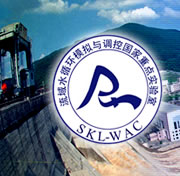《Water Science and Engineering》刊登“有渗透裂缝的混凝土重力坝的抗震稳定分析”
作者:Shou-yan JIANG, Cheng-bin DU
刊物:《Water Science and Engineering》,2012年,5卷第1期: 105-119页
关键词:抗震稳定;混凝土重力坝;渗透裂缝;塑性损伤模型;硬接触算法;库仑摩擦模型;接缝开裂
摘要:本文对一个有裂缝大坝的抗震稳定性进行了检测。同时考虑了几何形状的非线性和大变形,以及裂缝处的接触条件。利用基于非线性有限元法(FEM)的混凝土塑性损伤模型确定出渗透裂缝的位置。然后利用硬接触算法模拟法线方向裂缝的互相作用,利用库仑摩擦模型模拟切线方向裂缝的相互作用。通过一案例研究验证数值模型后,以不同的地震峰值加速度详细讨论存在两种渗透裂缝的Koyna大坝的抗震稳定性,并介绍开裂大坝的溃损过程。结果表明:存在两种渗透裂缝的大坝在Koyna原始地震等级下能保证其稳定性,开裂的大坝有较大的抗震余度。在强震中开裂大坝的破坏过程可以分为两个阶段:滑动阶段和倾覆阶段。滑动阶段末期接近峰值加速度,在倾覆发生之前顶部块体将沿裂缝滑动很长一段距离。顶部块体的最大滑动位移将随裂缝处摩擦系数的增大而减小。
Seismic stability analysis of concrete gravity dams with penetrated cracks
Authors: Shou-yan JIANG, Cheng-bin DU
Journal:《Water Science and Engineering》,2012, 5(1): 105-119
Key Word: seismic stability; concrete gravity dam; penetrated crack; plastic-damage model; hard contact algorithm; Coloumb friction model; joint opening
Abstract:The seismic stability of a cracked dam was examined in this study. Geometric nonlinearity and large deformations, as well as the contact condition at the crack site, were taken into consideration. The location of penetrated cracks was first identified using the concrete plastic-damage model based on the nonlinear finite element method (FEM). Then, the hard contact algorithm was used to simulate the crack interaction in the normal direction, and the Coloumb friction model was used to simulate the crack interaction in the tangential direction. After verification of numerical models through a case study, the seismic stability of the Koyna Dam with two types of penetrated cracks is discussed in detail with different seismic peak accelerations, and the collapse processes of the cracked dam are also presented. The results show that the stability of the dam with two types of penetrated cracks can be ensured in an earthquake with a magnitude of the original Koyna earthquake, and the cracked dam has a large earthquake-resistant margin. The failure processes of the cracked dam in strong earthquakes can be divided into two stages: the sliding stage and the overturning stage. The sliding stage ends near the peak acceleration, and the top block slides a long distance along the crack before the collapse occurs. The maximum sliding displacement of the top block will decrease with an increasing friction coefficient at the crack site.
原文链接:http://www.waterjournal.cn:8080/water/EN/abstract/abstract164.shtml
翻译:燕家琪;审核:安鹏

